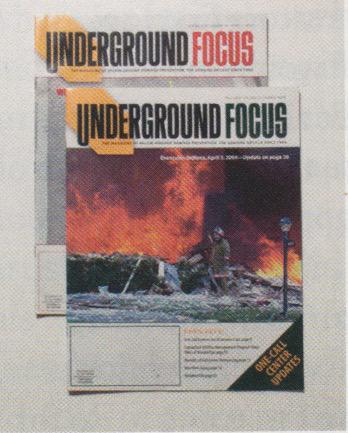
I got a job in college back in 1978 working for a utility contractor for a summer. When I graduated, the same contractor offered me a full-time job. That’s really when I developed a passion for locating underground pipes and cables. Twenty-some years later, I decided to start an underground locating training facility, and about that time I bought Underground Focus, thinking it would be a great complement to the training business.
These days, while other sections of the industry might be contracting, both our training program and the magazine are doing well. We print about fifteen thousand copies, nine times a year. Our readers are everyone from facility owners to excavators, engineers, and the businesses that manufacture underground locating equipment. We cover the entire underground damage prevention industry, and all that goes along with it, from the pipes to the cables that could be damaged during building construction and road repairs.
It’s a pretty small industry overall, but it’s an industry that works to bring order to excavation and hopes to limit the number of accidents that occur when underground utility lines are struck. Some accidents are just inconveniences, like a water line break. Others lead to death and years of litigation. In Toronto in 2003, a backhoe operator hit an unmarked gas line. Instead of breaking at the point of impact, the pipe broke apart further down the line, underneath a building. Eleven minutes later it exploded, killing seven people. It was Canada’s worst natural gas accident.
Let’s go back to the 1950s, when utility cables hung on above-ground poles. Utility maps were basically simple diagrams. They didn’t show location, because you knew where everything was, you could see it with your eyes. It wasn’t until the mid-1990s that mapping guidelines started to be developed. It’s still very much a work in progress, with unmarked utility lines crisscrossing each other across the country. That’s how we ended up with a lot of people in this industry believing in things like witching rods. They hold a set of coat hangers or welding rods in their hands and walk along until the rods either attract or repel from one another. When they do, they think they’ve found the location of the pipe or cable they’ve been trying to find. Imagine grabbing a couple of coat hangers and twisting them so that they form an L shape. Hold them in your hands, and walk.
One of our guys’ wives sits at a computer all day reading Google alerts on digging accidents. We then research the ones we think have the highest educational value or are particularly attention grabbing. Some of the editorial also focuses on my own vision of what damage prevention could be and where I think the industry is headed. Some of it’s what we call “One Word Scoop,” where we throw a question out to key figures in the industry and we publish their responses. We’re now becoming more image-focused, trying to let accident imagery do the heavy lifting of getting people to understand and be aware of what can go wrong and the need to focus on prevention.
We make up our own underground infrastructure terms. It’s not like we’re the world’s sharpest people, creating phrases and all, but a lot of the people who are training in this industry don’t have an electronics background, and they don’t have an electric theory background. They may not know a lot about the pipes and cables, or the construction practices used to put them in, or the materials used to make them. This whole business, this whole damage prevention business, involves stuff you can’t see. It’s weird, people think you can put on x-ray glasses and look below the ground. You absolutely can’t. It’s a blind business, and because it’s a blind business, we try to come up with terms and analogies that help people see what’s going on. People can’t see electromagnetic fields, which is actually what excavators first look for, but they can imagine what “pumpkin-shaped” would look like because they know what a pumpkin is. We also talk about rocks and ponds because we all know what happens when we throw a rock into a pond — we see ripples. That’s basically what’s happening with the electromagnetic fields as they leave underground pipes and cables.
There are two paths this business can go. We can either have more of the same, or we can truly try to change the way prevention is approached. I love my job, and this is the only thing I’m going to do for the rest of my life. I’m fifty years old. I’ve been in the business since I was twenty-three. At this point, what I’m trying to do is to be not only a visionary in the field, but also a catalyst for change. A central part of my mission is to get people to envision what damage prevention could be like if people did more than what the law requires, what their jobs require. I strongly believe that the work I’m doing here is going to result in a legacy of fewer accidents in decades to come.